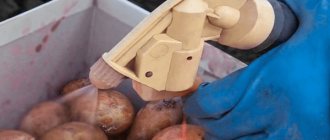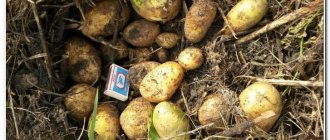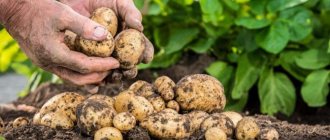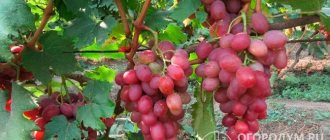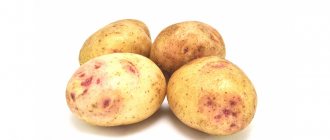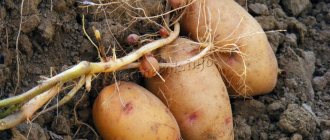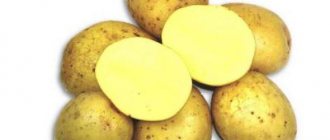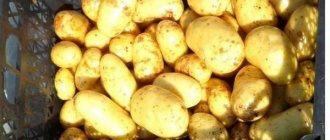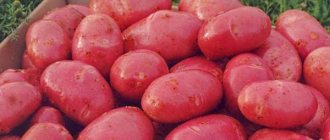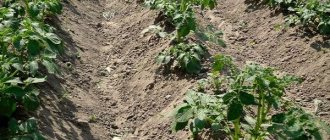Description of the Granada potato variety
Granada is a potato that belongs to the mid-late, high-yielding varieties. The height of the plant bush directly depends on the fertility of the soil. On depleted soils, the Granada bush can barely exceed 30 cm, while on fertile soils it can reach 0.8-1 m. The bush can have up to 8-10 erect stems. The leaves are wide and light green in color. Inflorescences have 6-8 buds. The flowers are white. From one bush you can collect up to 20 tubers.
Tubers of Grenada, as the variety is also called, have an almost regular oval shape. Thin peel of a pleasant yellowish color. The pulp is light and creamy in color, it is dense and does not change color when cut. A few ocelli are located superficially. The weight of the tuber varies from 175 to 250 g.
Granada potatoes originated in Germany
For your information! Potatoes, the Granada variety, are valued by farmers for their high yields. The manufacturer claims a yield of up to 600 centners per hectare. However, the practice of growing this potato variety has shown that from 1 hectare the yield is about 300-310 quintals of potatoes. On infertile soil, the yield will not be lower than 130 centners per hectare.
The marketability of the Grenada potato variety is 88-94%. The keeping quality of this variety is 97%, which is a record among similar varieties. The percentage of spoiled products during the storage period does not exceed 3. If the storage rules are followed, Granada potatoes will not germinate.
Potatoes of this variety have excellent presentation
Potato pulp has a high taste quality. Starch content 16-19%. This means that the potato boilability is average or below average. The color of the tubers does not change during heat treatment. The versatility of this variety allows it to be used for making purees, salads, as well as frying and baking.
Short description
The bush of this potato is a medium-height plant with semi-erect, moderately spreading and abundantly leafy stems. The leaves are quite large, light green. Granada flowers are white, with a faint anthocyanin tint on the inside of the corolla. In the beds, the plants look well-groomed and are a pleasure to admire.
The root system of the Granada potato is well developed, producing up to 15 potatoes, almost identical in size. The tubers are distinguished by a slightly elongated oval shape and evenly distributed small eyes. Under the thin yellow skin of this potato there is pulp of the same color (or slightly lighter), which has excellent taste. It does not darken when cut, mechanically damaged, or heat treated.
Preparing for landing
Preparations for planting potatoes begin as soon as the crop has been harvested. Only the largest tubers are selected, without signs of fungal diseases or mechanical damage.
About a month before planting, the tubers are placed in a wooden or plastic box and sprinkled with a peat-earth mixture. Next, the box is covered with film and placed in a bright place. In this case, the ambient temperature must be at least 12 °C. Germination will begin in 14-20 days.
Note! Before planting, it is necessary to remove weak or thin sprouts from tubers with hatched eyes, leaving the two strongest and most viable ones.
Features of cultivation and care
Many farmers and experts from the West rate the taste of this variety at 4.8 points out of 5 possible. As a result of the large amount of starch in the tubers, they do not darken or become soft during the cooking process.
As for cultivation and care, the variety is not particularly whimsical. It is better to use large tubers dug up from the best bushes as planting material. Such careful selection will contribute to a healthy and rich harvest.
Growing seedlings
The selected planting material is laid out in one layer in wooden boxes and covered with a mixture of peat and soil. To obtain seedlings, the boxes are covered with polyethylene and placed in a sunny place. Optimal storage conditions will be a temperature in the range of 12-140C. The appearance of sprouts can be noticed after 2-3 weeks.
Important! For planting, you can take 1-2 sprouts from one root crop, otherwise the yield indicators will sharply decrease.
Planting in open ground
You can plant seedlings in early May, when the ground is sufficiently warmed up and the risk of frost has completely disappeared.
When planting potatoes, the distance between the rows must be left 60-70 cm, which will provide the bushes with good air exchange and illumination, and will also simplify the process of hilling and processing the planting.
It is recommended to leave a distance of 20-25 cm between each bush. To improve the microclimate and retain moisture at the stage of planting potatoes, you can mulch them.
Depending on the type of soil, potatoes are planted at different depths. For clay soils, a depth of up to 5 cm is quite suitable, and for a looser composition this value increases to 12-13 cm.
Care
To get a good harvest of Granada potatoes, you must follow the following care rules.
- Regularly hill up the bushes, which promotes the proper development of underground shoots. In addition, it allows you to insulate weak and tender young shoots.
- The variety can easily tolerate dry weather. If spring assumes regular precipitation, then watering the potatoes is not required until the first flowers appear. In the absence of rain, it is advisable to moisten the soil every 1.5 weeks.
- It is good to use chicken manure as fertilizers, as well as a composition of superphosphate, urea and sulfate. For the first time, fertilizing is applied a month after planting the seedlings.
Hilling and weeding
Granada is planted when the soil warms up to 8-10 °C. Simultaneously with the creation of holes, fertilizing is applied, for example, wood ash or potassium phosphate fertilizer. Mulching the rows will prevent the spread of weeds and will retain moisture during dry periods.
Hilling up potatoes is a very important procedure that can significantly improve the quality of the crop. This is due to the fact that it stimulates the development of shoots. In addition, hilling helps solve a number of other problems:
- knocks down the bush, preventing it from falling apart;
- promotes the formation of new shoots, thanks to which productivity can increase by 30%;
- improves soil aeration;
- reduces the number of new weeds.
Hilling Granada helps solve many problems and improve the quality of tubers
Watering
Potatoes are a crop that requires a special approach to watering. On the one hand, it does not tolerate dry periods well, on the other hand, waterlogging of the soil is fraught with damage to the bush and root system by fungal diseases. Therefore, you should adhere to the universal rules that were developed by breeders and tested in practice by experienced farmers.
Grenada potatoes should be watered several times per season:
- watering is first carried out when the first shoots appear;
- the next time Granada is watered is when the bud formation has finished;
- The last time you need to water the potatoes is when flowering has ended.
Important! Subsequently, the lack of moisture is compensated by precipitation. If Granada potatoes are grown in the southern regions, where drought is a common occurrence, nothing needs to be done, since the variety is perfectly adapted to such climatic conditions.
Plant care
Plants must be fertilized regularly.
Characteristics of the species classify Granada potatoes as undemanding varieties. The species is drought-resistant, so when there is a moderate amount of rain, you don’t need to water it at all until flowering. Plants are demanding when it comes to fertilizing.
It is recommended to weed the soil between the rows several times a season, freeing it from weeds. Loosening the soil is an important step. This improves soil aeration and prevents moisture stagnation.
Hilling
This procedure should be carried out at least 2 times until the plants ripen. At the beginning, mounds of 10 cm are made, and when sprouts appear, 15 cm are made. The second time, hilling is carried out 3 weeks after the first.
Melt water: reviews, homemade recipe, beneficial properties, tips for use
On fertile soils the bushes grow tall and branched. Hilling is necessary not only to protect the crop from possible frosts, but also to form a neat bush. This procedure helps increase productivity. During hilling, additional underground stems are formed.
Feeding
In total, from the moment of planting, fertilizers are applied 4 times. For the first time, mineral mixtures or ash are used when planting. The soil is then fertilized 28 days after planting. Fertilize with urea, potassium sulfate or superphosphates.
The third time fertilizer is applied at the moment of bud formation and the fourth time after flowering. It is recommended to use urea as fertilizer. Organic fertilizers must be used very carefully so as not to burn the roots. If it is litter, add 0.5 kg per 10 liters of water and leave for a week. Then the plants are watered.
Top dressing
Fertilizing potatoes is an important component of a rich harvest. Each cultivator has his own time-tested recipe for applying fertilizers. However, they can be reduced to general universal rules.
Autumn feeding consists of adding humus, superphosphate and potassium sulfate at the rate of 6 buckets/30-35 g/20 g. Spring feeding is the application of nitrogen fertilizers, which are contained in large quantities in manure.
Another feeding is required when the first shoots appear and the first hilling is carried out. Chicken manure is used for this. You need to make a solution of 1 part litter and 15 parts water. Let it brew for a day. The plant should be fertilized at the rate of 1 liter per bush.
Diseases and pests
Granada potatoes are at risk of developing Alternaria blight, a disease that affects both the above-ground and underground parts of the plant. To prevent infection, before planting it is necessary to treat the seed tubers with a broad-spectrum antifungal drug. This will also protect the plant from Fusarium wilt. If preventive measures are not taken, the crop may be completely lost.
Fusarium wilt
Pests are another significant threat to Granada potatoes. Traditionally this is the Colorado potato beetle. In the fight against this insect, it is necessary to use both insecticidal preparations and manual collection of larvae and adults from bushes.
Harvesting
Since the Grenada potato variety is a mid-late variety, full ripening occurs only at the end of August. Tubers are removed from the ground using a shovel. The bush is held by the tops and carefully dug up.
After the potatoes are dug, it is necessary to sort the tubers. The largest ones are selected for planting next year. Those fruits that show signs of disease are discarded and destroyed.
Note! Potatoes that have mechanical damage should be consumed first. The rest needs to be prepared for storage.
Preparation consists of treating the tubers with a solution of copper sulfate at the rate of 3 g per 10-liter bucket of water. It is advisable to carry out processing in such a way as to cover the entire mass.
Storage
Granada potatoes are stored at a temperature of 2-4 °C. If the temperature regime is disturbed, the taste of potatoes can be significantly reduced. In addition, if the specified parameters are exceeded, potatoes may begin to sprout.
To store tubers, organize a dark, dry, well-ventilated place. A cellar would be ideal. Potatoes are placed in cellular boxes and installed in such a way that they do not touch the walls of the cellar. This will allow air to circulate freely between the tubers, preventing putrefactive processes from developing.
The harvest is stored in a special container that allows air to pass through well.
Important! Grenada potatoes need to be inspected once a month. If rotten tubers are found, they must be destroyed immediately.
Potato storage
The potato harvest begins in mid-August or early September, it all depends on the day the tubers are planted. You need to dig up the tubers in dry weather, so that you can immediately sort them out and put them in the cellar (in households) or place them in a warehouse. In the room where vegetables will be stored, it is necessary to maintain an optimal microclimate. The storage temperature should be within +2-4°C. If it is higher, the tubers will begin to wither, and if lower, they will freeze. The air humidity in the cellar or vegetable storage should be at 70-80%. Tubers should be placed in nets or containers with good air circulation.
Advantages and disadvantages of the variety
Advantages of the variety:
- high yield rates;
- taste qualities are beyond praise;
- impeccable presentation;
- undemanding to cultivation conditions;
- ability to tolerate even prolonged drought;
- good keeping quality.
Disadvantages of the variety:
- susceptibility to certain types of rot.
Grenada is a potato that has gained popularity among gardeners and farmers in a fairly short time. And this is not at all surprising, since this potato has much more advantages than disadvantages.
